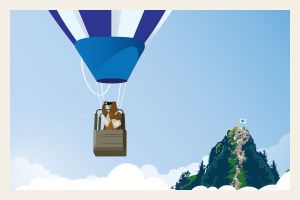Many companies use upselling as a key strategy to increase sales amongst existing customers, while simultaneously cultivating and strengthening long-term customer relationships. But beyond being a means of encouraging customers to buy higher-end versions of products, what is upselling, really?
Upselling is a way of offering consumers an improved all-around experience and helping them find the best version of a product to suit their wants and needs. In order to do that most effectively, it’s important to understand the psychology behind the consumer decision-making process, so you can identify ideal upsell opportunities.
Upsell Opportunities Start with Understanding Your Consumer
In Salesforce’s State of the Connected Customer survey, 66% of respondents stated that they were likely to switch companies if they felt they were being treated like a number rather than an individual.
Becoming acquainted with your customer’s wants and needs is not only key to understanding the psychology of consumer decision-making, but also crucial to retaining customers in the first place.
At its core, upselling is a method of developing trusting relationships with existing customers and – like any successful relationship – that involves attentiveness, understanding, and support.
Some examples of how to employ these skills to identify upselling opportunities:
1. Make the Most out of Every Interaction
Customers today have more ways to engage with companies than ever before: according to Marketing Week, roughly 50% of customers regularly use more than four touchpoints when buying an item. They interact and share information over a variety of channels, such as social media, email, online reviews, phone calls and in-person meetings.
One of the most straightforward ways to learn more about your customers is to actively listen to them and pay close attention as they identify their preferences and needs throughout every type of interaction. Customers will often directly hand you the information you need to spot upsell opportunities.
Some techniques for getting the most from customer interactions include:
- Asking open-ended questions to allow customers to discuss their thoughts in detail, rather than eliciting yes or no answers.
Paying attention to their online engagement such as customer reviews, social media interactions, page views, posts, shares, etc. With 43% of Salesforce survey respondents citing that they use social media to voice their opinions about brands and products, it’s clear that there is a large pool of valuable information ready for the taking.
Looking at purchase history, since it is a definitive way of seeing which products are in demand and which customers have bought things from you in the past. As cited in the book Marketing Metrics, “the probability of selling to a new prospect is 5%-20%. The probability of selling to an existing customer is 60-70%.” Knowing your existing customers and where your money comes from can provide you with useful data to prioritise upsell strategies.
- Considering customer interaction across departments, and not just with the sales team. Useful information may be revealed in a wide range of situations. For example, a customer might contact tech support for help with a task that could be better accomplished with an upgraded version of the product, creating a clear upsell opportunity.
- Using a CRM platform to keep track of customer behaviours and demographic information. A good CRM can help you track everything from social media interactions to previous purchases, creating a detailed picture of your customers.
2. A Little Awareness Goes a Long Way
The State of the Connected Customer survey also shows that nearly half of UK consumers are likely to switch brands if a company doesn’t anticipate their needs. Putting yourself in your customers’ shoes is a useful way to gain insight into how upselling can be used to provide actual benefits.
Some questions to consider include:
- What products or services are already available on the market? Is something currently unavailable that your company could potentially develop? Are your competitors offering any products that you could improve upon?
- Can you improve upon your own existing products? If you already offer a basic version, would it be possible to also provide an upgraded version?
- What is appropriate for the needs and financial limitations of your target customer? It might be hard to upsell a top-of-the-line sports car to a middle-class parent of four, but the roomy and practical family van could be a perfect match.
3. Offer Support in the Form of Useful Information (Instead of a Sales Pitch
As many as 73% of UK consumers agree it’s very important or critical that salespeople they interact with are focused on their needs, not just making a quick sale. Keeping customers well informed of the options available to them allows them to decide what they really need.
Rather than pushing the upsell alone, make sure customers know what your company has to offer and how it can benefit them. One way to do so is by using marketing automation to send customers messages once they’ve met certain criteria so that they’re receiving the right messages at the right time. If listening is one half of the upsell dialogue, then this is the other. It might turn out that upsell opportunities increase as the dialogue continues.
Using Psychology to Seize Opportunities
A big part of being able to identify upsell opportunities is understanding customer behaviours and the psychology behind the decision-making process. Knowing your customer’s mindset can make all the difference when it comes to upselling, as you will have a better idea of whether the timing is right and how likely they are to make a purchase.
1. Upsell When Customers are Ready to Buy
According to research by Implisit, only 13% of leads turn into opportunities, and only 6% of those opportunities turn into deals. This suggests that you can only be sure that customers within that 6% will actually buy something.
Preparing to make a purchase is the only definitive indicator that your customer is in a buying mood, making it the moment when they are most open to taking suggestions. Thus, the ideal moment to offer the upsell is when the customer has selected a product and is ready to buy it, but still hasn’t gone through checkout.
Just be wary of pushing too hard without being fully informed of his or her needs – asking a few questions first can be helpful in assessing the situation.
2. Ready to Buy is Also Ready to Pay
If a customer is ready to buy a product, then he or she has accepted that it will cost a certain amount of money.
Once the customer is resigned to paying the asking price, you can focus on how little it would cost to make an upgrade. If it’s a small leap from what they were already willing to pay, there’s a good chance the upsell will be a success.
3. Everyone Enjoys Feeling Like They Get a Deal
In fact, 83% of customers report comparing prices online before going shopping. In general, customers will be more eager to accept your upsell if they feel like they are receiving some sort of bargain.
That being said, they won’t always automatically understand that what you’re offering is actually a better money-to-value ratio. When upselling, make sure it’s clear that you’re helping your customers get the most for their money.
4. Scarcity and Urgency Make Products Seem More Valuable
A report found that 56% of businesses show higher click-to-open rates on emails that were about flash sales. Why is that? Because the flash sales all lasted less than 24 hours, giving customers a sense of urgency and making them feel the need to act quickly.
Likewise, Crazy Egg co-founder Neil Patel describes scarcity as “any limitation placed on a product or service with the goal of increasing sales through pressure placed on the consumer. The fear of missing out causes people to make the decision to buy.”
When upselling, you can use certain techniques like creating limited-time offers, using “urgent” colours and images (like highlighting the price in red or incorporating a large button), and displaying numbers to show how many are left in stock or have been sold. Such strategies make products seem more valuable and urge customers to grab a deal before it’s too late.
5. A Sense of Reciprocity Leads to Loyalty (and Sales)
In his article “Upsells, Upgrades, and Building Customer Trust”, Roger Dooley describes a situation in which someone at a rental car company tries to convince him to upgrade his rental to a higher-priced car. In the end, he turns it down, only to find out that the nicer car was the only one available and it would have been his either way.
He goes on to explain:
“Offering me the nicer car at the same price would have invoked the principle of reciprocity, which happens when one person gives something to another person with no conditions or quid pro quo. That basic psychological principle, once triggered, would make it far more likely that I would recommend this company to others and rent from them again.”
When customers feel that a company is providing them with something of value without expecting anything in return, they are more inclined to give something back by making a purchase or recommending the company to others.
It is important to keep reciprocity in mind when upselling, as it could be the reason a customer is interested in buying something from you – just as neglecting it could backfire as it did in Dooley’s article.
Understanding these customer behaviours not only makes it easier to spot upsell opportunities but also to create more. With an awareness of certain psychological triggers, you can create strategies that will maximise your upselling success.
Getting to Know Each Other – the Key to Successful Upselling
The best way to effectively upsell your products is to get to know your customers and the thinking behind their decision-making processes. This is done by honing in on your relationships, being a good listener, and putting yourself in their shoes.
Once you have a sense of the customers’ mindset and behaviours, you’ll know when the timing is right and which strategies to use.
This post is part of our Navigating the Sales Cycle series. Download the e-book and discover the 7 steps to sales success.

























